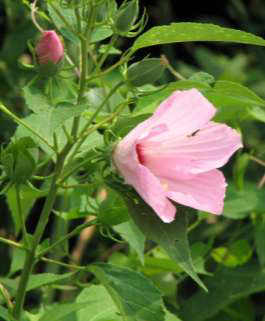 Swamp Rose Mallow
Swamp Rose Mallow
(Hibiscus moscheutos Welw. ex Hiern.)
|
Classification |
| Kingdom: |
Plantae |
| Division: |
Magnoliophyta |
| Class: |
Magnoliopsida |
| Order: |
Malvales |
| Family: |
Malvaceae |
| Genus: |
Hibiscus |
| Species: |
moscheutos |
 Characteristics: The Swamp Rose Mallow is a multi-stemmed, shrub-like, herbaceous perennial. It can grow up to 7 feet tall. The leaves are usually 2 to 3 inches wide by 6 to 8 inches long, velvety to the touch on the underside and smooth on top. The flowers are about 6 inches in diameter, with white or pink petals and crimson centers. The swamp-rose mallow dies back in winter and re-sprouts in the spring. It reproduces via seeds or root division.
Characteristics: The Swamp Rose Mallow is a multi-stemmed, shrub-like, herbaceous perennial. It can grow up to 7 feet tall. The leaves are usually 2 to 3 inches wide by 6 to 8 inches long, velvety to the touch on the underside and smooth on top. The flowers are about 6 inches in diameter, with white or pink petals and crimson centers. The swamp-rose mallow dies back in winter and re-sprouts in the spring. It reproduces via seeds or root division.
Habitat: The swamp rose mallow inhabits swamps, marshes and ditches; it grows best in full sun.
Range: It can be found throughout the southeastern United States from Texas to the Atlantic states with its territory extending northward to southern Ontario.
Native American Uses: It is unknown if local Native American Tribes utilized this species; however the Shinnecock Indians used it as a urinary aid and to treat inflamed bladders.
Modern Uses: This type of hibiscus is not edible, but it is commonly used as decoration or as natural borders. They are also effective along streams or ponds.